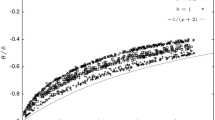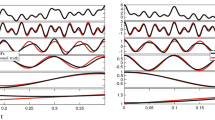Abstract
The empirical mode decomposition (EMD) is a powerful tool in signal processing. Despite its algorithmic origin making its theoretical analysis and formulation very difficult, a few recent works has contributed to its theoretical framework. Herein, the former local mean is formulated in a more convenient way by introducing operators to calculate local upper and lower envelopes. This enables the use of differential calculus and other classical calculations on the new local mean. Based on its more accurate formulation, a partial differential equation (PDE) consistency result is provided to approximate the sifting process iterations, without any envelope interpolation. In addition, a new stopping criterion based on the introduced local mean is proposed. This new criterion is a local measure and resolves the null integral conservative property of the previous derived PDE, which made any signal having a null integral be a PDE-based mode. Moreover, the δ inner model parameter is now linked to the signal intrinsic properties, providing to the latter a physical meaning and making the proposed model keep the auto-adaptive property of the EMD. New decomposition modes are now analytically and fully characterized, and also interpolation free. Finally, properties of the interpolation free PDE model are presented. Results obtained with our proposed approach by explicit computations thanks to the eigendecomposition of the Laplacian operator, and also by numerical resolution of the derived PDE, show noticeable improvements for both stationary and non stationary signals, in comparison to the former EMD algorithm.
Similar content being viewed by others
References
Huang, N.E., Shen, Z., Long, S.R., Wu, M.C., Shih, H.H., Zheng, Q., Yen, N.-C., Tung, C.C., Liu, H.H.: The empirical mode decomposition and the Hilbert spectrum for nonlinear and non-stationary time series analysis. Proc. R. Soc. A 454, 903–995 (1998)
Cexus, J., Boudraa, A.: Teager-Huang analysis applied to sonar target recognition. International Journal of Signal Process 1(1), 23–27 (2004)
Boudraa, A., Cexus, J., Salzenstein, F., Guillon, L.: IF estimation using empirical mode decomposition and nonlinear Teager energy operator. In: Proc. IEEE ISCCSP, pp. 45–48. Hammamet, Tunisia (2004)
Cexus, J., Boudraa, A.: Nonstationary signals analysis by Teager-Huang Transform (THT). In: EUSIPCO, 5 p., Florence, Italy (2006)
Bouchikhi, A., Boudraa, A., Ramdane, S.B., Diop, E.-H.: Empirical mode decomposition and some operators to estimate instantaneous frequency: a comparative study. In: Proc. IEEE ISCCSP, pp. 608–613. Malta (2008)
Kazys, R., Pagodinas, D., Tumsys, O.: Application of the Hilbert-Huang signal processing to ultrasonic nondestructive testing of composite materials. Ultragarsas 50(1), 17–22 (2004)
Oonincx, P.J., Hermand, J.P.: Empirical mode decomposition of ocean acoustic data with constraint on the frequency range. In: Proceedings of the Seventh European Conference on Underwater Acoustics, ECUA 2004, Delft, The Netherlands (2004)
Liang, H., Bressler, S.L., Buffalo, E.A., Desimone, R., Fries, P.: Empirical mode decomposition of field potentials from macaque V4 in visual spatial attention. Biol. Cybern. 92, 380–392 (2005)
Cai, C., Liu, W., Fu, J.S., Lu, Y.: A new approach for ground moving target indication in foliage environments. Elsevier Signal Process. 86, 84–97 (2006)
Benramdane, S., Cexus, J.C., Boudraa, A.O., Astolfi, J.A.: Time-frequency analysis of pressure fluctuations ona hydrofoil undergoing a transient pitching motion using Hilbert-Huang and Teager-Huang transforms. In: ASME PVP 2007/CREEP 8, San Antonio, Texas, USA (2007)
Wu, Z., Huang, N.E.: A study of the characteristics of white noise using the empirical mode decomposition method. Proc. R. Soc. A 460, 1597–1611 (2004)
Flandrin, P., Rilling, G.: Empirical Mode Decomposition as a Filter Bank. IEEE Signal Process. Lett. 11(2), 112–114 (2004)
Mallat, S.: Une exploration des signaux en ondelettes. L. E. de l’École Polytechnique, Ed., Novembre (2000)
Cohen, L.: Time-Frequency Analysis. E. C. Prentice Hall, Ed., NJ (1995)
Daubechies, I., Lu, J., Wu, H.-T.: Synchrosqueezed wavelet transforms: an empirical mode decomposition-like tool. Appl. Comput. Harmon. Anal. (2010). doi:10.1016/j.acha.2010.08.002
Delechelle, E., Lemoine, J., Niang, O.: Empirical mode decomposition: an analytical approach for sifting process. IEEE Signal Process. Lett. 12(11), 764–767 (2005)
Sharpley, R.C., Vatchev, V.: Analysis of the intrinsic mode functions. Constr. Approx. 24, 17–47 (2006)
Meignen, S., Perrier, V.: A new formulation for empirical mode decomposition based on constrained optimization. IEEE Signal Process. Lett. 14(12), 932–935 (2007)
Vatchev, V., Sharpley, R.: Decomposition of Functions into Pairs of Intrinsic Mode Functions. Proc. R. Soc. A 464, 2265–2280 (2008)
Diop, E.H.S., Alexandre, R., Boudraa, A.O.: Analysis of intrinsic mode functions: a pde approach. IEEE Signal Process. Lett. 17(4), 398–401 (2010)
Diop, E.H.S., Alexandre, R., Boudraa, A.O.: A PDE model for 2D intrinsic mode functions. In: IEEE ICIP, pp. 3961–3964. Cairo, Egypt (2009)
Diop, E.H.S., Alexandre, R., Moisan, L.: Intrinsic nonlinear multiscale image decomposition: a 2D empirical mode decomposition-like tool. Comput. Vis. Image Underst. 116(1), 102–119 (2012)
Nunes, J., Bouaoune, Y., Delechelle, E., Niang, O., Bunel, P.: Image analysis by bidimensional empirical mode decomposition. Elsevier Image Vis. Comput. 21, 1019–1026 (2003)
Damerval, C., Meignen, S., Perrier, V.: A fast algorithm for bidimensional EMD. IEEE Signal Process. Lett. 12(10), 701–704 (2005)
Xu, Y., Liu, B., Liu, J., Riemenschneider, S.: Two-dimensional empirical mode decomposition by finite elements. Proc. R. Soc. A 462(2074), 3081–3096, (2006)
Frei, M.G., Osorio, I.: Intrinsic time-scale decomposition: time-frequency-energy analysis and real-time filtering of non-stationary signal. Proc. R. Soc. A 463, 321–342 (2007)
Flandrin, P., Goncalves, P.: Empirical mode decompositions as data-driven wavelet-like expansions. IJWMIP 2(4), 1–20 (2004)
Boashash, B.: Time Frequency Signal Analysis and Processing: A Comprehensive Reference. Elsevier, The Boulevard, Langford Lane, Kidlington, Oxford OX5 1GB, UK (2003)
Rice, S.O.: Mathematical analysis of random noise. Bell Syst. Tech. J. 23, 282–332 (1944)
Cexus, J.C.: Analyse des signaux non-stationnaires par transformation de huang, opérateur de Teager-Kaiser, et transformation de Huang-Teager. Ph.D. dissertation, Université de Rennes 1 (2005)
Rilling, G.: Décompositions Modales Eempiriques. Contributions à la théorie, l’algorithmie et l’analyse de performances. Ph.D. dissertation, École Normale Supérieure de Lyon (2007)
Hou, T.Y., Yan, M.P.: A variant of the EMD method for multi-scale data. AADA 1(4), 483–516 (2009)
Chen, Q., Huang, N., Riemenschneider, S., Xu, Y.: A b-spline approach for empirical mode decompositions. Adv. Comput. Math. 24(1), 171–195 (2006)
DiBenedetto, E.: Partial Differential Equations, ch. 4, pp. 208–209. Birkhäuser, Boston, USA (1995)
Diop, E.H.S.: A PDE-based approach for the 1D and 2D empirical mode decomposition, and AM-FM models for image analysis. Ph.D. dissertation, Université de Rennes 1, France (2009)
Pinchover, Y., Rubinstein, J.: An Introduction to Partial Differential Equations. Cambridge University Press (2005)
Allaire, G.: Numerical Analysis and Optimization. Oxford University Press Inc., New York, USA (2007)
Flandrin, P.: Available Online. http://perso.ens-lyon.fr/patrick.flandrin/emd.html (2007). Accessed Sept 2011
Wu, Z., Huang, N.E.: Ensemble empirical mode decomposition: a noise-assisted data analysis method. AADA 1(1), 1–41 (2009)
Boudraa, A.O., Cexus, J.C., Saidi, Z.: EMD-based signal noise reduction. International Journal of Signal Processing 1(1), 33–37 (2004)
Savitzky, A., Golay, M.J.E.: Smoothing and differentiation of data by simplified least squares procedures. Anal. Chem. 36(8), 1627–1639 (1964)
Author information
Authors and Affiliations
Corresponding author
Additional information
Communicated by Yuesheng Xu.
Rights and permissions
About this article
Cite this article
Diop, E.H.S., Alexandre, R. & Perrier, V. A PDE based and interpolation-free framework for modeling the sifting process in a continuous domain. Adv Comput Math 38, 801–835 (2013). https://doi.org/10.1007/s10444-011-9260-x
Received:
Accepted:
Published:
Issue Date:
DOI: https://doi.org/10.1007/s10444-011-9260-x
Keywords
- Eigenfunctions
- Eigenvalues
- Empirical mode decomposition
- Intrinsic mode functions
- Partial differential equations




